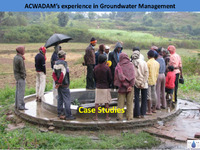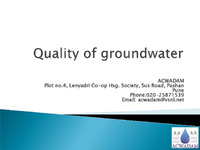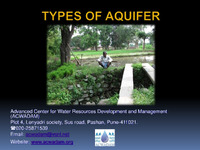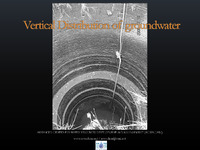Items
Tag
Aquifer
-
 Experience in Groundwater Management Case Studies_ACWADAM ACWADAM's groundwater management initiatives highlight successful community-based strategies in three villages: Pondhe, Muthalane, and Randullabad. In Pondhe, a formal water user group system is established to manage irrigation solely through dug wells, with regulations to prevent overexploitation and ensure equitable water distribution. Muthalane, a tribal region, focuses on community participation and sustainable practices, with new wells and repairs planned to enhance water access. Randullabad employs effective monitoring and management of its aquifers, promoting sustainable irrigation practices. Overall, these case studies demonstrate the importance of community engagement and strategic planning in groundwater management.
Experience in Groundwater Management Case Studies_ACWADAM ACWADAM's groundwater management initiatives highlight successful community-based strategies in three villages: Pondhe, Muthalane, and Randullabad. In Pondhe, a formal water user group system is established to manage irrigation solely through dug wells, with regulations to prevent overexploitation and ensure equitable water distribution. Muthalane, a tribal region, focuses on community participation and sustainable practices, with new wells and repairs planned to enhance water access. Randullabad employs effective monitoring and management of its aquifers, promoting sustainable irrigation practices. Overall, these case studies demonstrate the importance of community engagement and strategic planning in groundwater management. -
 GROUNDWATER BALANCE The groundwater balance in an aquifer involves the assessment of inputs like recharge from precipitation and outputs such as discharge from pumping and baseflow. Different watershed scenarios can affect this balance, with variations in aquifer types—deep, shallow, or a combination. Key components include groundwater pumping, which significantly impacts the natural flow and baseflow contributions to streams. The balance can be quantified by measuring discharge and calculating specific yield, which estimates storage changes. For effective management, understanding the relationship between recharge (38% of rainfall) and discharge is crucial, ensuring sustainable aquifer levels amid varying climatic conditions.
GROUNDWATER BALANCE The groundwater balance in an aquifer involves the assessment of inputs like recharge from precipitation and outputs such as discharge from pumping and baseflow. Different watershed scenarios can affect this balance, with variations in aquifer types—deep, shallow, or a combination. Key components include groundwater pumping, which significantly impacts the natural flow and baseflow contributions to streams. The balance can be quantified by measuring discharge and calculating specific yield, which estimates storage changes. For effective management, understanding the relationship between recharge (38% of rainfall) and discharge is crucial, ensuring sustainable aquifer levels amid varying climatic conditions. -
 Quality of Ground Water Access to safe drinking water is a fundamental human right, yet in India, groundwater, which supplies 90% of rural and over 45% of urban water, often suffers from quality issues due to overexploitation and industrial contamination. Many districts report high levels of harmful substances like fluoride and arsenic, affecting millions with water-borne diseases and health risks. Groundwater quality varies based on geological factors and human activities, necessitating regular sampling and analysis to monitor safety. Improved community awareness, traditional purification methods, and sustainable management practices are essential for enhancing water quality and ensuring public health.
Quality of Ground Water Access to safe drinking water is a fundamental human right, yet in India, groundwater, which supplies 90% of rural and over 45% of urban water, often suffers from quality issues due to overexploitation and industrial contamination. Many districts report high levels of harmful substances like fluoride and arsenic, affecting millions with water-borne diseases and health risks. Groundwater quality varies based on geological factors and human activities, necessitating regular sampling and analysis to monitor safety. Improved community awareness, traditional purification methods, and sustainable management practices are essential for enhancing water quality and ensuring public health. -
 Types of aquifer An aquifer is a rock formation that stores water and can release it for use, functioning as an underground reservoir. There are two main types: unconfined aquifers, which are directly connected to the atmosphere and fluctuate in water levels due to recharge and discharge, and confined aquifers, which are surrounded by impermeable layers and maintain water under pressure. Water can flow from unconfined aquifers to the surface, creating springs, while base flow from these aquifers contributes to stream flow, especially during dry seasons. Perched aquifers are small, limited extensions of unconfined aquifers, retaining groundwater above an impermeable layer.
Types of aquifer An aquifer is a rock formation that stores water and can release it for use, functioning as an underground reservoir. There are two main types: unconfined aquifers, which are directly connected to the atmosphere and fluctuate in water levels due to recharge and discharge, and confined aquifers, which are surrounded by impermeable layers and maintain water under pressure. Water can flow from unconfined aquifers to the surface, creating springs, while base flow from these aquifers contributes to stream flow, especially during dry seasons. Perched aquifers are small, limited extensions of unconfined aquifers, retaining groundwater above an impermeable layer. -
 Vertical Distribution of Groundwater Groundwater is distributed in subsurface zones with varying characteristics. The zone of rock fracture contains openings that can hold water, while below it, the dense rock zone has limited water capacity. The zone of aeration is partially filled with air and water, supporting vegetation, while the zone of saturation is fully water-saturated, with the water table marking its upper boundary. This saturated zone can be accessed through wells, which reveal groundwater levels. Vadose hydrology, occurring above the water table, plays a crucial role in managing water transfer between surface and groundwater, influencing factors like precipitation and moisture management.
Vertical Distribution of Groundwater Groundwater is distributed in subsurface zones with varying characteristics. The zone of rock fracture contains openings that can hold water, while below it, the dense rock zone has limited water capacity. The zone of aeration is partially filled with air and water, supporting vegetation, while the zone of saturation is fully water-saturated, with the water table marking its upper boundary. This saturated zone can be accessed through wells, which reveal groundwater levels. Vadose hydrology, occurring above the water table, plays a crucial role in managing water transfer between surface and groundwater, influencing factors like precipitation and moisture management.